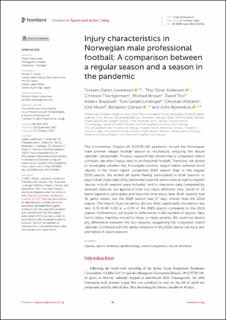| dc.contributor.author | Dalen-Lorentsen, Torstein | |
| dc.contributor.author | Andersen, Thor Einar | |
| dc.contributor.author | Thorbjørnsen, Christian | |
| dc.contributor.author | Brown, Michael | |
| dc.contributor.author | Tovi, David | |
| dc.contributor.author | Braastad, Anders | |
| dc.contributor.author | Lindinger, Tom Gerald | |
| dc.contributor.author | Williams, Christian | |
| dc.contributor.author | Moen, Eirik | |
| dc.contributor.author | Clarsen, Benjamin Matthew | |
| dc.contributor.author | Bjørneboe, John Andreas | |
| dc.date.accessioned | 2023-01-06T18:33:18Z | |
| dc.date.available | 2023-01-06T18:33:18Z | |
| dc.date.created | 2022-11-04T15:14:03Z | |
| dc.date.issued | 2022 | |
| dc.identifier.citation | Frontiers in Sports and Active Living. 2022, 4, Artikkel 915581. | |
| dc.identifier.issn | 2624-9367 | |
| dc.identifier.uri | https://hdl.handle.net/11250/3041686 | |
| dc.description | This is an open-access article distributed under the terms of the Creative Commons Attribution License (CC BY). The use, distribution or reproduction in other forums is permitted, provided the original author(s) and the copyright owner(s) are credited and that the original publication in this journal is cited, in accordance with accepted academic practice. No use, distribution or reproduction is permitted which does not comply with these terms. | en_US |
| dc.description.abstract | The Coronavirus Disease-19 (COVID-19) pandemic forced the Norwegian male premier league football season to reschedule, reducing the fixture calendar substantially. Previous research has shown that a congested match schedule can affect injury rates in professional football. Therefore, we aimed to investigate whether the Norwegian premier league teams suffered more injuries in the more match congested 2020 season than in the regular 2019-season. We invited all teams having participated in both seasons to export their injury data. Only teams that used the same medical staff to register injuries in both seasons were included, and to maximize data comparability between seasons, we applied a time-loss injury definition only. Seven of 13 teams agreed to participate and exported their injury data. Both seasons had 30 game weeks, but the 2020 season was 57 days shorter than the 2019 season. The match injury incidence did not differ significantly [incidence rate ratio 0.76 (0.48–1.20; p = 0.24) in the 2020 season compared to the 2019 season. Furthermore, we found no differences in the number of injuries, days lost to injury, matches missed to injury, or injury severity. We could not detect any differences between the two seasons, suggesting the congested match calendar combined with the safety measures in the 2020 season can be a safe alternative in future seasons. | en_US |
| dc.language.iso | eng | |
| dc.subject | epidemiology | en_US |
| dc.subject | football | en_US |
| dc.subject | injuries | en_US |
| dc.subject | match congestion | en_US |
| dc.subject | soccer | en_US |
| dc.subject | sports medicine | en_US |
| dc.title | Injury characteristics in Norwegian male professional football: A comparison between a regular season and a season in the pandemic | |
| dc.type | Peer reviewed | |
| dc.type | Journal article | |
| dc.description.version | publishedVersion | |
| dc.rights.holder | © 2022 Dalen-Lorentsen, Andersen, Thorbjørnsen, Brown, Tovi, Braastad, Lindinger, Williams, Moen, Clarsen and Bjørneboe | en_US |
| dc.source.pagenumber | 10 | |
| dc.source.volume | 4 | |
| dc.source.journal | Frontiers in Sports and Active Living | |
| dc.identifier.doi | 10.3389/fspor.2022.915581 | |
| dc.identifier.cristin | 2069366 | |
| dc.description.localcode | Institutt for idrettsmedisinske fag / Department of Sports Medicine | en_US |
| dc.source.articlenumber | 915581 | en_US |
| cristin.ispublished | true | |
| cristin.fulltext | original | |
| cristin.qualitycode | 1 | |
